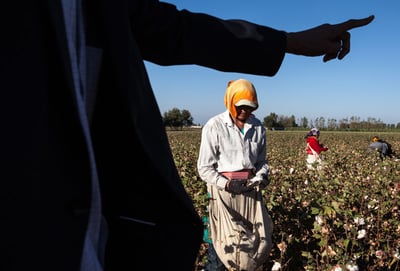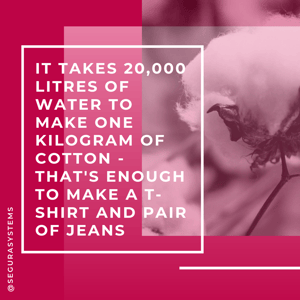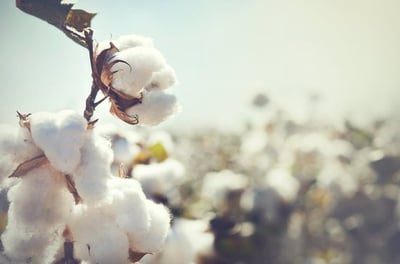WHAT IS COTTON?
Cotton is a natural fibre from the seedpod of the cotton plant, a member of the Mallow family which includes many species. In total, four of the 30 recognised species of cotton are commercially cultivated. As the cotton plant is a natural perennial, it lasts for more than one season, meaning it is harvested at the same time each year. To grow, the plant requires tropical conditions for approximately half of the year, as well as plenty of moisture.
The fibres that surround the cotton plant are spun into a strong thread and then woven into cloth or knitted. Once the fabric has been dyed, printed or embroidered, it can be used across the many industries; to make items such as clothes, textiles and even banknotes.
THE IMPACT OF UNSUSTAINABLE COTTON SOURCING
The impact of the industry is far reaching, with Fairtrade Foundation estimating that up to 100 million households are directly engaged in cotton production. A whitepaper published by Fashion Revolution in 2015 stated that there are 200 million people in total working across the entire cotton sector.
SLAVERY
Historically, the impact of cotton sourcing has had huge links to slavery. In the 1800s, cotton was one of the world’s most luxurious commodities and became the first mass consumer commodity. The high value of cotton is partly due to the cheap (or non-existent) labour costs involved in its production at the height of the slave trade. According to Steven Deyle, the value of slaves in 1860 was “roughly three times greater than the total amount invested in banks”.

Today, the link between cotton farming and slave labour still exists. From early September each year, the Uzbekistani government requires thousands of citizens to leave their homes and professions to pick cotton. According to the local governments this process is voluntary, but according to local monitors reporting to the Uzbek-German Forum of Human Rights, the move is compulsory with those who cannot or will not pick cotton being extorted for money.
Photo credit: Anti-slavery
ENVIRONMENTAL IMPACT

The environmental impacts of cotton production not only lays within the raw materials stage, but throughout the entire manufacturing process from farming to product.
Approximately 20,000 litres of water is needed to produce one kilogram of cotton – this is enough to manufacture one t-shirt and one pair of jeans. An estimated 8,000 chemicals are used during the process of turning raw materials into textiles; these chemicals are then released into freshwater sources, causing pollution. The residues left over from the process can have detrimental effects on human life, including damage to reproductive systems, as well as being toxic, carcinogenic and mutagenic.
RETAILERS AND BRANDS’ NEED FOR COTTON
Uzbekistan is the world’s fifth largest cotton exporting country and so cotton produced there – potentially through forced labour – is sold into the major garment manufacturing hubs worldwide. This then enters retail supply chains across the globe, including some of the world’s most prosperous countries. Cotton is the most used of all the world’s fibres, accounting for almost 40% of global textile production.
Currently, cotton production requires substantial amounts of water, chemicals, energy and land – while global natural resources dwindle in the warming climate…Fossil fuels cannot be spun into polyester or other synthetic fabrics for ever, either. Yet, much clothing is discarded before the end of its life span and ends up in landfill sites. This project vows to drastically improve the ecological footprint of garments by encouraging and promoting tangible solutions.
WWF Finland’s Miiju Sirviö
on WWF’s collaboration with the Nordic Fashion Week Organisation
ACHIEVING SUSTAINABLE COTTON SOURCING
Only 12% of the world’s cotton is currently classed as sustainable which raises the question: how can we source cotton sustainably?
The issues that are associated with the cotton supply chain are tackled from various angles by a wide range of different organisations. The most prominent organisations are the Better Cotton Initiative (BCI), Organic Cotton and Fairtrade Cotton.
BETTER COTTON INITIATIVE
BCI is an organisation that aims to transform cotton production worldwide by training cotton growers on how to improve pesticide management, water use efficiency and soil fertility. The training also aims to improve health and safety for cotton growers, promote freedom of association and reduce forced labour and child labour. Cotton growers must adhere to specific production and management practices and show continuous improvement in the sustainability of those practices. Verification is accomplished through self-assessments and second party credibility checks, together with some third-party assessments.
 ORGANIC
ORGANIC
What sets Organic Cotton apart from the other initiatives is that they not only ban genetically modified cotton, but also all forms of insecticide and pesticide use. It focuses on agronomic processes rather than input-based conventional production, meaning they aim to establish a diverse and balanced ecosystem for various crops. For example, crop varieties are selected based on local conditions in climate, soil, pests and diseases. The standard has a decentralised implementation system that is verified by third party certification agencies, and a product cannot be certified Organic if human rights or labour standards (outlined by the International Labour Organisation) have been breached.
FAIRTRADE
Whilst Organic cotton focuses more on environmental considerations in the cotton supply chain, Fairtrade focuses more on imbalance in trading relationships together with social and economic development for small farmers. Hence the two standards are often combined, with 65% of Fairtrade cotton in the world also being Organic. Fairtrade’s main objective is to provide fair remuneration and further economic benefits to producers and their organisations, ensuring the costs of sustainable cotton production are covered, basic decent work standards are respected, and upfront credit is offered. Apart from the fair minimum price, farmers are also paid a premium that is earmarked for social and economic projects.
HOW RETAILERS AND BRANDS CAN TACKLE UNSUSTAINABLE SOURCING DIRECTLY
By associating itself with BCI, Organic Cotton or Fairtrade Cotton, a retailer or brand is taking the first step to achieving sustainable sourcing. Collaboration and the sharing of knowledge stands all businesses on a better platform from which to improve sustainability across the industry.
In order to go further, it is essential that retailers and brands address the issue of unsustainable cotton within their supply chain directly. Supply chain transparency – a view of the entire supply chain from raw material to end production – is key. Done successfully, this can provide retailers and brands with information regarding not only their first-tier suppliers, but all of the suppliers across and within their entire downstream supply chain. A 2015 Behind the Barcode report found that 91% of 219 brands surveyed did not know where their cotton comes from.
Supply chain transparency is the first step in allowing retailers and brands to trade on their own terms when it comes to sustainability.
Originally Published 25/09/2018


